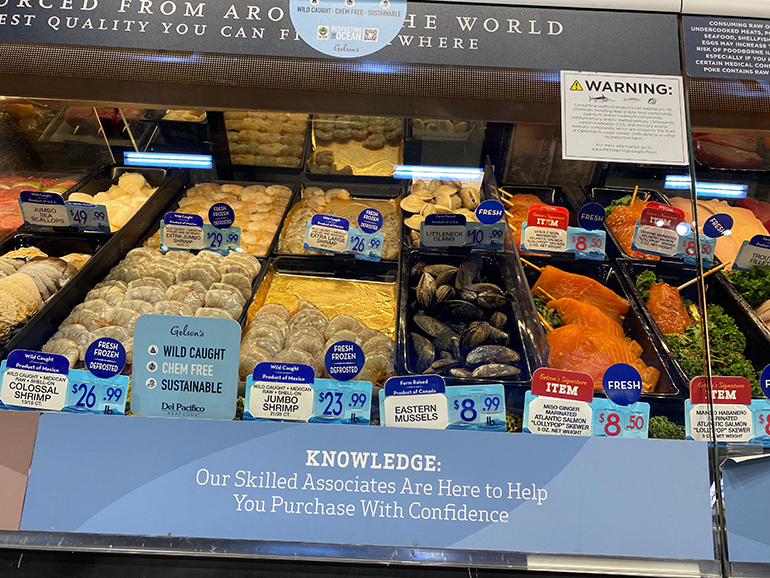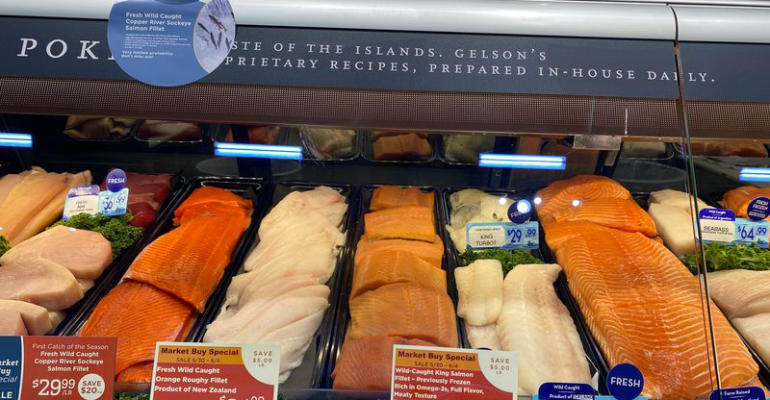Shelf life, a key factor in consumers’ decisions to purchase fresh proteins, is proving to be an especially powerful sales obstacle for seafood merchandisers.
Because many shoppers perceive that seafood will go stale quicker than alternative proteins, and particularly meat and poultry, it is essential that retailers leverage efficient supply chains and packaging that will ease shopper concerns, analysts said.
Seventy-six percent of consumers, for instance, a seven-point increase from a year earlier, indicate that freshness has a growing and significant impact on their seafood purchasing decisions, states the Power of Seafood 2024 report, published by Arlington, Va.-based FMI — The Food Industry Association. Other influencing factors include smell/odor (cited by 69% of consumers, up from 64%), and how quickly it goes bad (60%).
In addition, 66% of seafood eaters rank quality as an important factor when shopping for seafood, followed by taste/flavor (52%), total price (47%), price per pound (36%), and product appearance (32%). When selecting a primary seafood store, 49% of consumers list quality/freshness as the top factor, trailing only price (54%). “Concern about food waste can be seen in the many seafood consumers who say how quickly it goes bad and whether the family will like it,” the Power of Seafood states.

Seafood counters are a valuable vehicle for creating the perception of quality.
“Real and perceived quality are critical for enticing new shoppers and gaining repeat sales,” said Chuck Anderson, partner and vice president of sales and operations at Certified Quality Foods, a Dallas-based analyzer of seafood quality. Previously, he was the vice president of seafood procurement for Quincy, Mass.-based Ahold USA and the category manager for seafood at San Antonio-based H-E-B. “Retailers need to focus on great sourcing and sanitation to provide high-quality fish.”
That can include obtaining locally caught seafood to help extend shelf life and maintaining a clean and attractive seafood department, he said, noting that a “fishy odor in the store will crush consumer confidence quickly.”
Offering shoppers a double-your-money-back guarantee will also provide operators with the extra incentive to market the freshest seafood, Anderson said. “Employees will then think twice before selling questionable products,” he said. “Retailers can gain more in sales and profit than what is lost in returns.”
Live fish tanks, along with displaying whole, gutted fish will further illustrate that the store is committed to offering the freshest seafood possible, Anderson said.
Retailers, however, must always keep freshness top of mind if they are to maximize product shelf life, Anderson said. “That means buying the best quality available, minimizing supply chain delays, and using the best packaging technologies,” he said.
In developing supply chains, merchandisers should leverage systems that reduce the distance between the areas where seafood are caught and retail outlets, he said, adding that stores that only market seafood that arrives the same day would create a solid quality aura.
“It is acceptable for retailers to run out of selections if it means only the freshest options are always available,” Anderson said. “Distribution must be efficient with an in-today and out-today mentality both in the distribution center and at store level. Tell customers that you run out often, and that is why the stock is always great quality. Teach them to ask for the freshest items instead of what is on sale.”
Operators can further accentuate freshness by having employees cut seafood in-store, which includes slicing products into fillets and steaks, and offering fillets in packages with 10K OTR film, which provides a skintight, oxygen-permeable barrier, he said. “That takes worker training and a commitment to the seafood program” from the corporate office, which includes investing in the necessary production and merchandising resources, Anderson said.
The presence of a seafood counter creates an impactful perception of quality and expertise as well, the Power of Seafood states, noting that 74% of seafood shoppers, and 82% of frequent seafood shoppers who consume seafood at least two times a week, indicate that it is very or somewhat important that their seafood stores have seafood counter staff. In addition, 48% of seafood consumers indicate that they are looking for freshness information from the seafood counter, while 37% seek data on where the seafood is from.
Retailers also can emphasize equality by offering ice with every purchase to keep the fish cold and fresh until it reaches home, along with furnishing handling instructions, Anderson said.
“Seafood managers need training to identify questionable and low-quality products, while having the authority to remerchandise or absorb shrink,” he said. “Quality must be the priority to drive sales and keep shrink and expenses low. One bad experience can be expensive and permanently turn off the consumers.”





